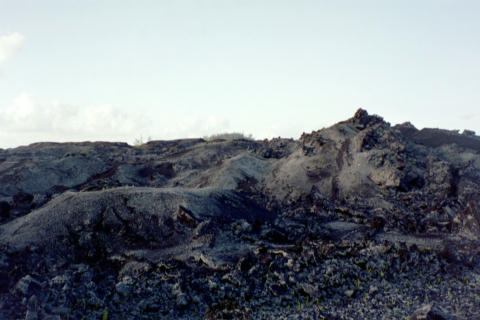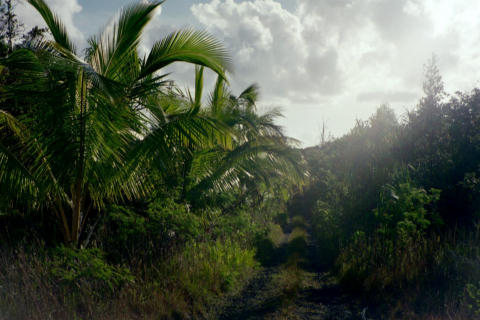
Our homestead on a 76 acre parcel of land that is a combination of lava rock and tropical rain forest.
The water and the
air are probably the freshest on the planet. "Hawaii-
The Big Island Revealed"
puts it like this.
"Tale a deep breath. This is the easternmost part of the island, and since
our winds come from that direction, scientists use it to test "virgin air"
that has drifted over the landless Pacific for many weeks. Air from here
is considered as pristine as any in the world, and it is analyzed by governments
around the globe and used as a benchmark to compare to their air."
Because the land is the most eastern part of the island chain of Hawaii, the Kahunas once lived on the property I caretake. There is a large stone hedge monument buried under 30 feet of lava from the 1960 flow. It was thought to help the Kahunas (healers) follow the seasons since this is the first place the rising sun hits the islands.
The coastline is currently boulder rocks, but it becomes sandy at times. The surf is generally rough 75% of the time, but a good swimmer could go in most of the time in the morning before the tradewinds create greater wave size and turbulence. The closest bay is about 1.5 miles away. It has volcanically heated tide pools. The active lava flow is currently about 16 miles away.
We thought we would
start our tour with what you would see driving in from the main road.
 |
After turning off the paved road, you find yourself on one mile of black cinder road , the view to either side looks much like this; lava rock from the 1960 lava flow which destroyed all but two neighborhoods in what used to be the town of Kapoho. |
 |
A little further down the road you get a clearer view of what is called the Kipuka, the rain forest land that was spared from the lava flow. The Kipuka is considered sacred by local traditions. |
| Eventually, the cinder road ends and a combination dirt, rock, cinder, and grass road starts which winds right through the heart of the Kipuka. Our little Toyotas just love this part of the drive! |  |
 |
Driving through the Kipuka, you see a large number of Lau Hala trees, called the screwpine in English. It is believed that Hala was brought here by the ancient Polynesians who first settled these islands. They used its leaves to make thatch houses, baskets, hats, floor and sleeping mats, and even weaved it into sails for their ocean-going canoes. We find that the goats love to eat it whenever they get a chance! |
| A view from the path we take down to the ocean. |
 |
 |
A sunset from the lava rock shorefront, which is about 1500 feet from our house. |
 |
|
|
|
|
|
|
|
|
|
Internship Opportunities |
|
|
|